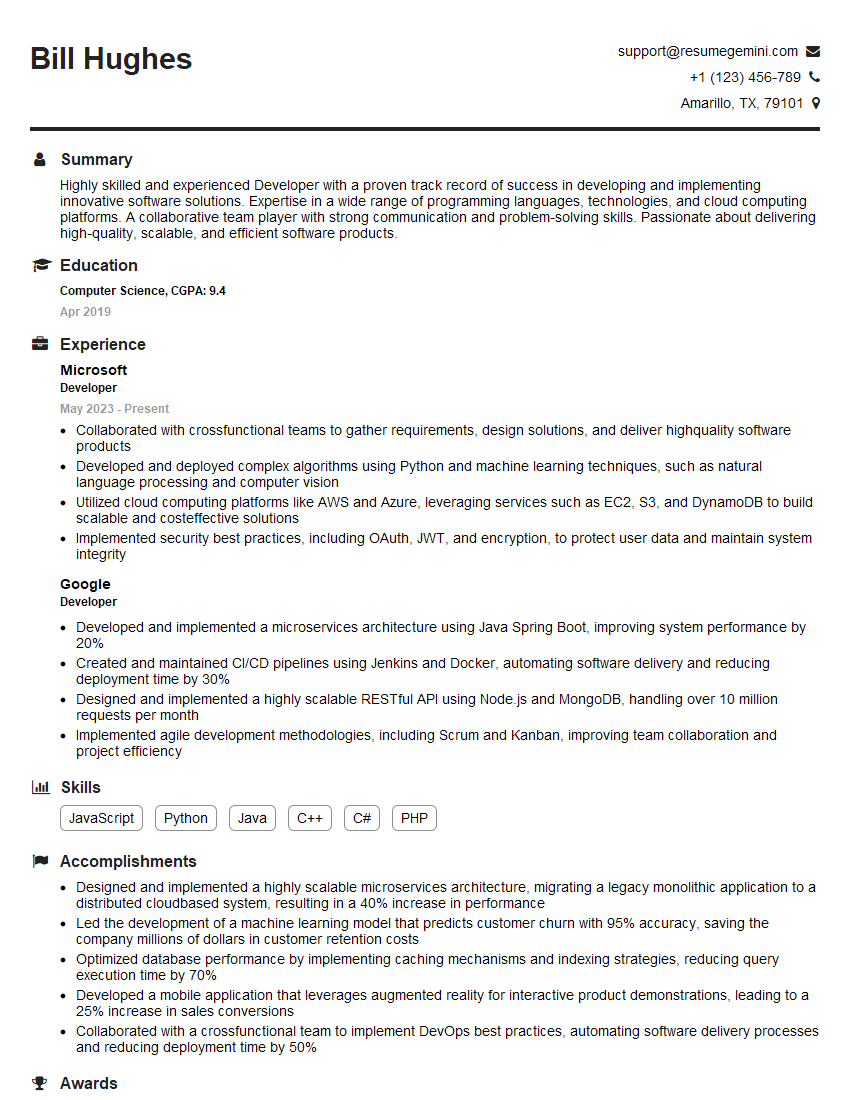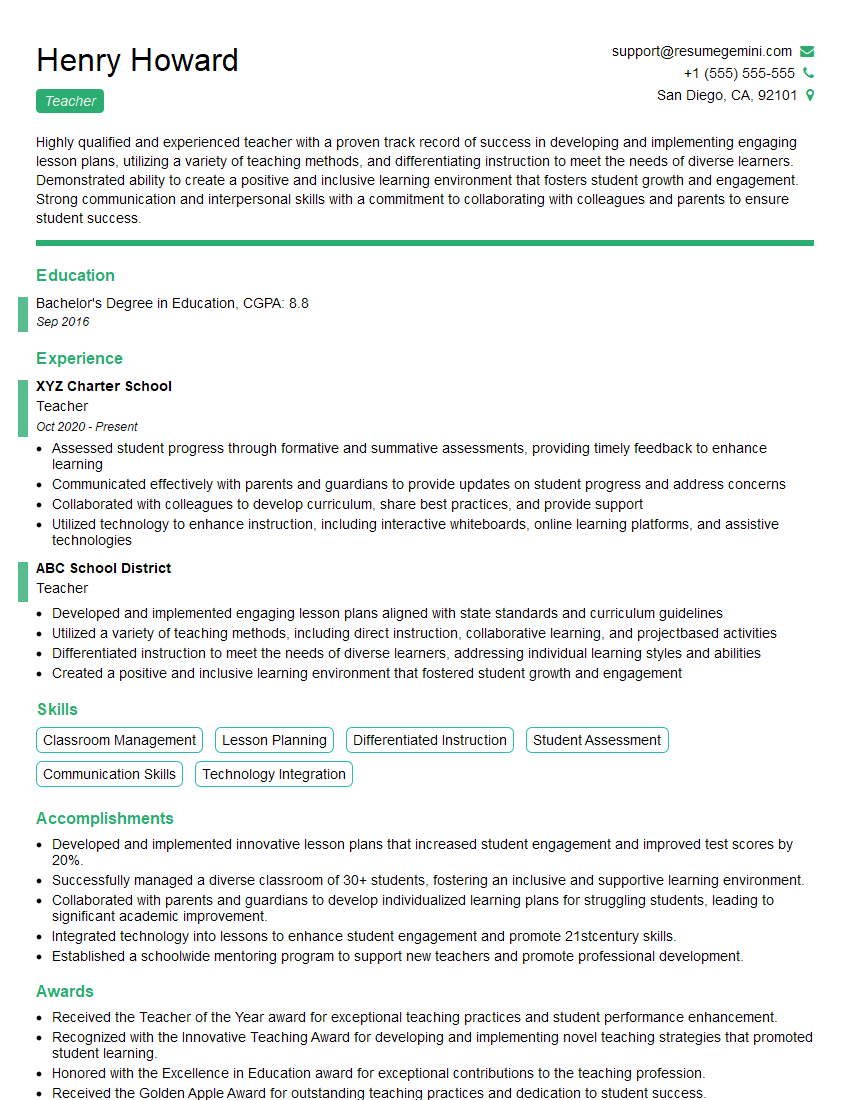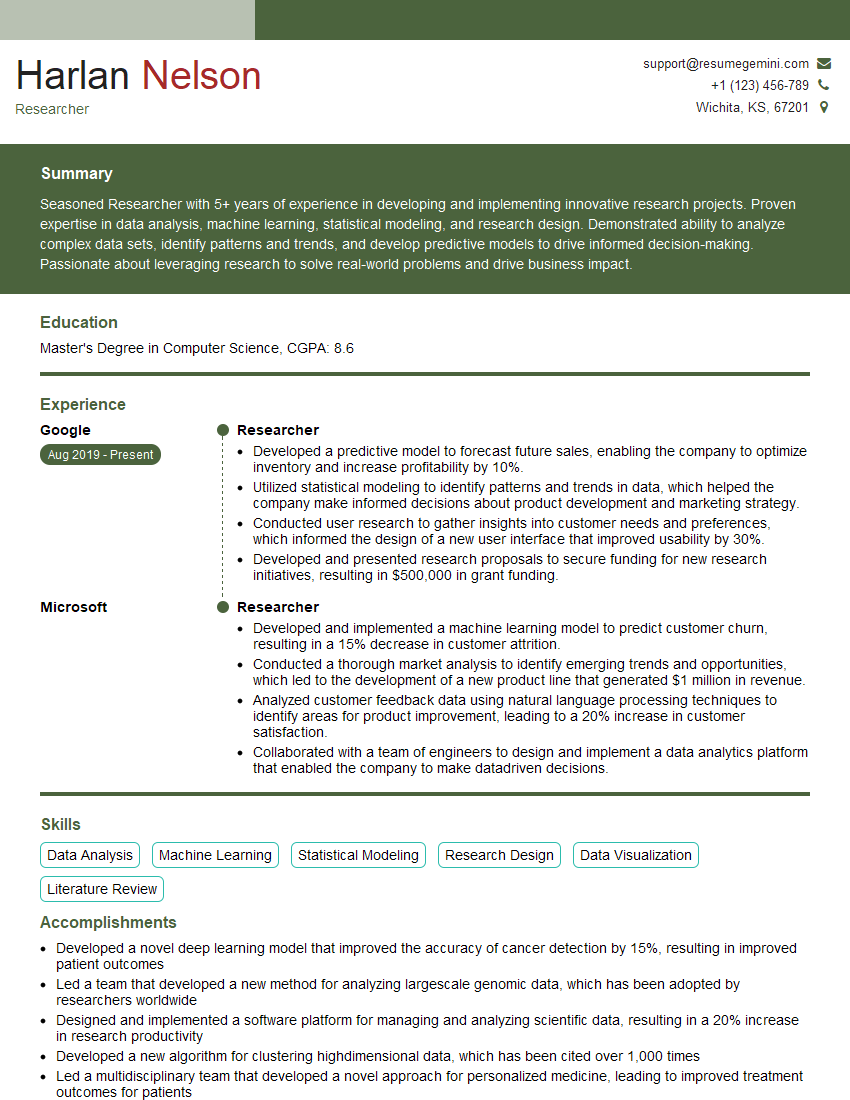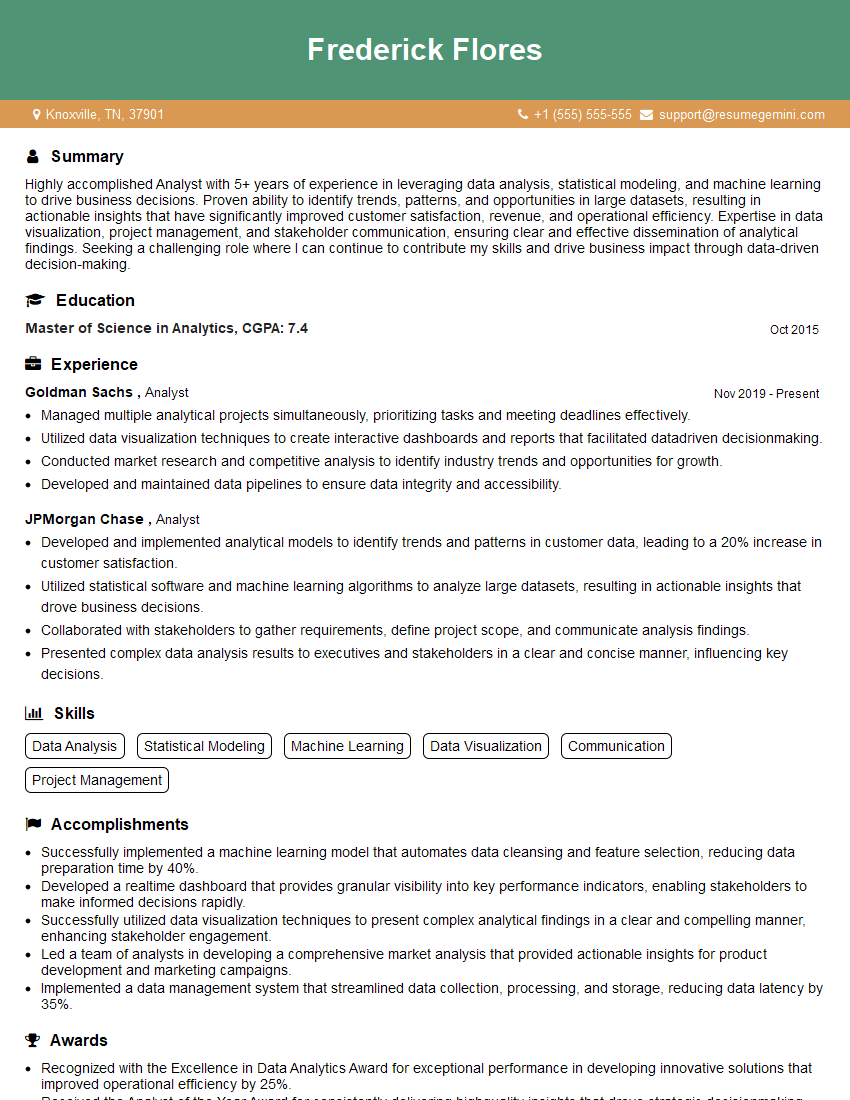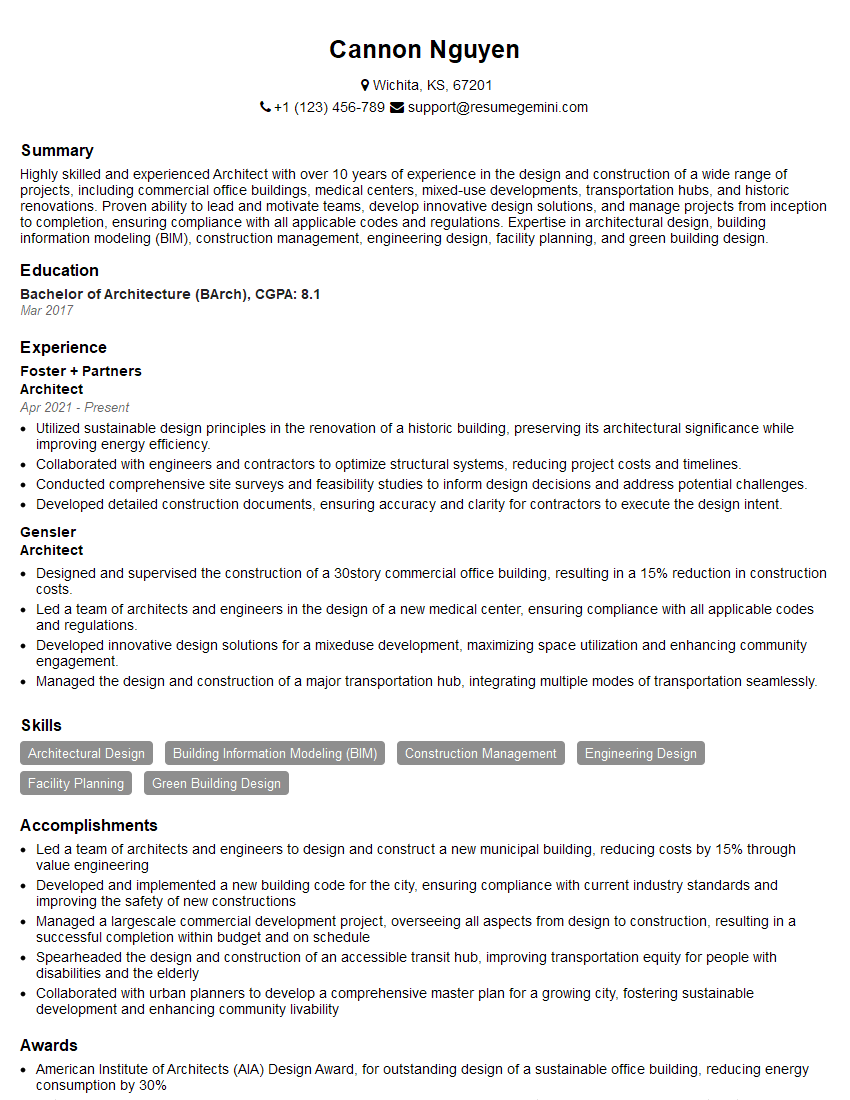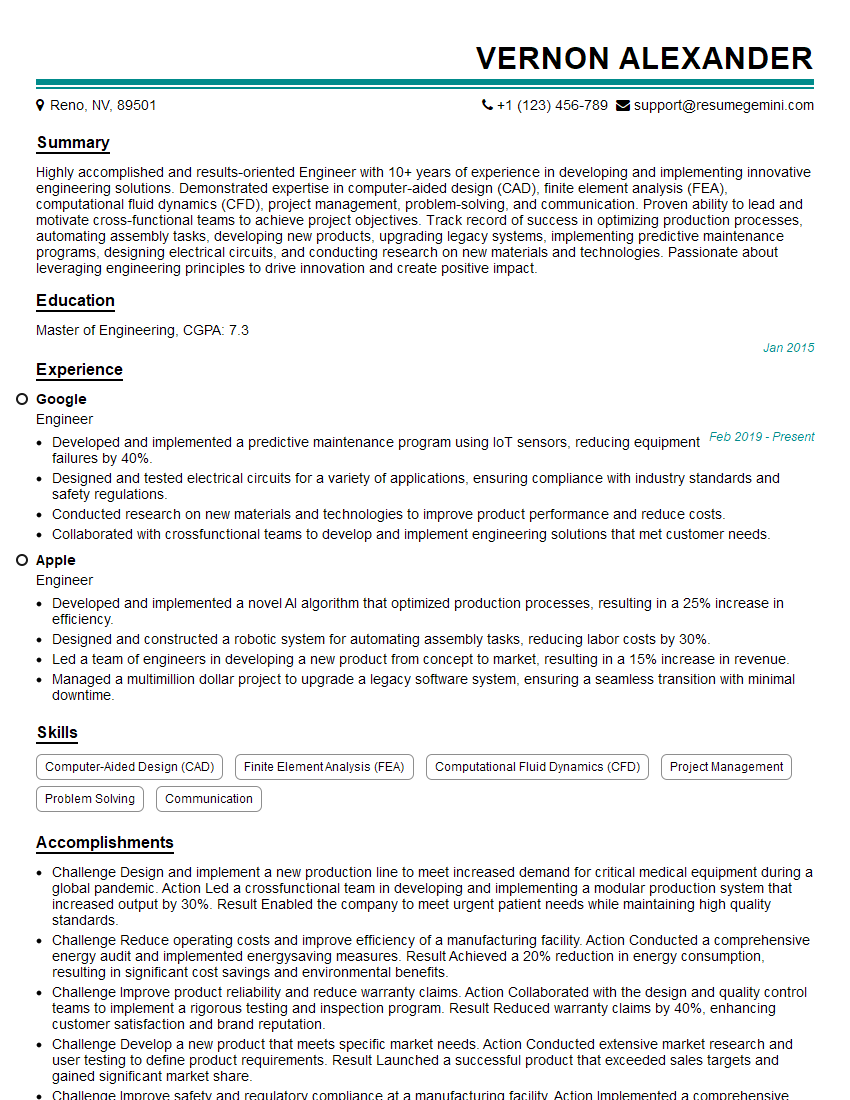The thought of an interview can be nerve-wracking, but the right preparation can make all the difference. Explore this comprehensive guide to Experience in working independently and as part of a team interview questions and gain the confidence you need to showcase your abilities and secure the role.
Questions Asked in Experience in working independently and as part of a team Interview
Q 1. Describe a project where you worked independently. What challenges did you face?
During my time at Acme Corporation, I undertook a solo project to redesign our internal knowledge base. My goal was to improve searchability and user experience, ultimately increasing employee efficiency. The project involved migrating data from an outdated system, redesigning the interface using a user-centered design approach, and implementing a new search algorithm.
The biggest challenge was the sheer volume of data – thousands of documents, many of which were poorly organized and lacked consistent formatting. This required meticulous data cleaning and categorization, a process that took far longer than initially anticipated. Another challenge was working without immediate feedback from a team. I had to be extremely self-motivated and disciplined to stay on track and ensure the final product met the quality standards I had set.
Q 2. How did you manage your time and prioritize tasks while working solo?
Managing time effectively when working independently requires a structured approach. For the knowledge base project, I started by breaking down the project into smaller, manageable tasks. I used a Kanban board (both physical and digital) to visualize my workflow, track progress, and prioritize tasks based on their urgency and importance. I set realistic deadlines for each task and regularly reviewed my progress against these deadlines. This allowed me to identify potential bottlenecks early and adjust my schedule accordingly. I also dedicated specific blocks of time for focused work, minimizing interruptions. The Pomodoro Technique, where you work in focused bursts followed by short breaks, proved particularly helpful in maintaining concentration.
Q 3. Describe a situation where you had to adapt your work style to accommodate a team member’s approach.
In a recent team project developing a new software module, I worked with a colleague who preferred a very detailed, step-by-step approach to development, while my preference is for a more agile, iterative approach. Initially, our differing styles led to some friction. To accommodate my colleague’s preference, I began by providing more detailed documentation and progress updates at each stage of development. I also incorporated more frequent code reviews into our workflow, allowing us to identify and resolve issues early on. This collaborative approach not only smoothed our working relationship but also led to a higher-quality final product as we leveraged each other’s strengths.
Q 4. Explain a time you successfully resolved a conflict within a team.
During a particularly demanding project deadline, a disagreement arose between two team members regarding the best approach to a critical component. One favored a more complex, but potentially more robust, solution, while the other preferred a simpler, quicker approach. To resolve this, I facilitated a meeting where each team member explained their reasoning, using data and evidence to support their position. I ensured everyone felt heard and understood. We then collaboratively evaluated the pros and cons of each approach, considering factors like time constraints, risk, and long-term maintainability. Ultimately, we reached a compromise that incorporated elements of both solutions, resulting in a satisfactory outcome for everyone involved. The key was active listening, focusing on finding a solution that met the overall project goals, and ensuring everyone felt their input was valued.
Q 5. How do you contribute to a positive team environment?
I contribute to a positive team environment by focusing on several key areas. Firstly, I actively listen to my colleagues and show genuine interest in their perspectives. I believe in open communication and encourage team members to share their ideas and concerns without fear of judgment. Secondly, I celebrate team successes and acknowledge individual contributions, fostering a sense of camaraderie and mutual respect. I also proactively offer support and assistance to colleagues who might be struggling with a task, demonstrating teamwork and collaboration. Lastly, I maintain a positive and optimistic attitude, even during challenging times, which helps to keep morale high and motivate the team.
Q 6. What strategies do you use to ensure clear communication in a team setting?
Clear communication is paramount for team success. My strategies include using various communication channels appropriately. For quick updates and informal discussions, instant messaging or quick calls work well. For detailed information or decisions, I opt for emails or documented meeting minutes. Regardless of the channel, I focus on being concise and clear in my messaging, using plain language and avoiding jargon. Before sending critical messages, I carefully review them to eliminate any potential ambiguities. Regularly scheduled team meetings, with a clear agenda and defined objectives, help maintain alignment and open dialogue among the team members.
Q 7. How do you handle disagreements with team members?
Disagreements are inevitable in any team setting. When faced with a disagreement, I approach it constructively by focusing on the issue at hand, rather than resorting to personal attacks. I listen attentively to the other person’s viewpoint, seeking to understand their perspective before stating my own. I look for common ground and areas of agreement. I aim to find a mutually agreeable solution that aligns with the project’s goals. If a resolution cannot be reached directly, I suggest seeking mediation from a neutral third party within the organization. Ultimately, the goal is to resolve the conflict respectfully and professionally, maintaining a healthy working relationship.
Q 8. Describe your preferred team communication methods.
My preferred team communication methods prioritize clarity, efficiency, and inclusivity. I find a multi-faceted approach works best, leveraging different tools depending on the context and urgency. For quick updates and informal discussions, instant messaging platforms like Slack are invaluable. For detailed discussions, project planning, and sharing documents, I prefer project management tools such as Jira or Asana. These platforms allow for organized task assignment, progress tracking, and version control of documents. For more formal communication or announcements, email remains a reliable method. Finally, regular team meetings (both in-person and virtual) are essential for fostering collaboration and ensuring everyone is on the same page. Open communication is key – I actively encourage team members to voice concerns or questions freely, regardless of the communication channel.
Q 9. Have you ever had to delegate tasks? How did you approach it?
Delegation is a crucial skill for effective teamwork. My approach involves careful consideration of the individual’s skills and experience. I start by clearly defining the task, setting realistic deadlines, and establishing clear expectations for deliverables. This includes outlining the desired outcome, outlining key performance indicators (KPIs), and providing any necessary resources or support. I then select the team member best suited for the task based on their strengths and expertise. The chosen individual is given the autonomy to complete the task, but I remain available for guidance and support if needed. Throughout the process, I maintain open communication to monitor progress and address any challenges that may arise. A crucial element is providing constructive feedback, both during the process and upon completion, to facilitate learning and continuous improvement. For example, when delegating a data analysis task, I wouldn’t simply say ‘Analyze this data.’ I’d outline specific questions the analysis should answer, the required format for the report, and the deadline, and ensure the team member has access to the necessary datasets and tools.
Q 10. How do you provide constructive feedback to colleagues?
Constructive feedback is about helping colleagues improve, not criticizing them. My approach focuses on the behavior, not the person. I use the SBI model (Situation, Behavior, Impact) to structure my feedback. First, I describe the specific situation where the behavior occurred. Second, I clearly state the behavior that needs improvement. Finally, I explain the impact that behavior had on the project, team, or individual. For instance, instead of saying ‘You’re always late,’ I might say, ‘During the last two project meetings, you arrived 15 minutes late (Situation). This resulted in a delay in starting the meeting (Behavior), which impacted our ability to review critical deadlines (Impact).’. Following this with a suggestion for improvement, such as suggesting they allocate a bit more time for travel, is also vital. This approach ensures the feedback is specific, actionable, and focused on improvement.
Q 11. How do you handle criticism from team members?
I view criticism as an opportunity for growth and improvement. My response depends on the nature of the criticism. If it’s constructive and well-intentioned, I listen carefully, ask clarifying questions, and thank the person for their feedback. I then consider the validity of the criticism and reflect on how I can improve. Even if the criticism is not entirely accurate or fairly delivered, I try to understand the perspective and address any underlying concerns. Sometimes, it’s simply a matter of miscommunication or differing expectations, which can be resolved through open and honest dialogue. However, if the criticism is personal or unprofessional, I address it directly and respectfully. I would reiterate the importance of constructive feedback and might seek mediation if the situation warrants it.
Q 12. How do you stay motivated when working independently?
Maintaining motivation when working independently requires self-discipline and proactive strategies. I set clear, achievable goals and break down large tasks into smaller, manageable steps. This creates a sense of accomplishment as I complete each step. I also incorporate regular breaks to avoid burnout and maintain focus. I find that prioritizing tasks based on urgency and importance helps to stay organized and on track. Additionally, I use a reward system to motivate myself – rewarding myself after completing a milestone with an enjoyable activity. Finally, I connect with colleagues regularly, even when working independently, to maintain a sense of teamwork and community, exchanging updates, insights, and challenges to maintain a feeling of engagement and avoid isolation.
Q 13. How do you ensure accountability when working as part of a team?
Accountability in a team setting is crucial for success. We establish clear roles, responsibilities, and deadlines from the outset, documented in project plans and using tools like shared task lists in project management software. Regular progress updates are essential, and these updates aren’t just one-way communication; open communication is imperative to flag concerns and address challenges before they escalate. We use regular team meetings to track progress, identify roadblocks, and ensure everyone is on the same page. Mutual peer review can also be effective, where team members review each other’s work, ensuring quality and highlighting areas for improvement. Transparency and open communication are paramount; this creates a culture of accountability where everyone feels responsible for their contributions and the overall success of the project.
Q 14. Describe a time you had to rely on others to complete a project.
In a previous project involving the development of a new software module, my role focused on the front-end design and user interface (UI). However, the back-end development and database integration were handled by another team member. While I could design the UI elements, the functionality was dependent on the successful completion of the back-end work. I proactively communicated with the back-end developer regularly, ensuring a consistent flow of information. We established clear milestones and dependencies, and used version control to ensure compatibility. When the back-end development encountered unforeseen delays, I worked closely with the developer to troubleshoot the issue and identify solutions, offering support and alternative strategies where possible. This collaborative approach was critical to ensuring the project was delivered on time and met the required specifications. The successful launch of the software module was a testament to the power of teamwork and effective communication when tasks are dependent on various team members’ expertise.
Q 15. How do you identify individual strengths within a team?
Identifying individual strengths within a team requires a multifaceted approach combining observation, communication, and a genuine interest in team members. It’s not just about identifying skills; it’s about understanding how those skills manifest in a team setting and how they contribute to overall success.
Observation: Pay close attention to how individuals tackle tasks, their problem-solving approaches, their communication style, and their interactions with others. Notice who excels at brainstorming, who’s detail-oriented, who’s a natural leader, and who thrives in supporting roles.
Direct Communication: Engage in one-on-one conversations with team members. Ask them about their strengths, their preferred work styles, and areas where they feel most confident. Create a safe space for honest self-assessment.
Performance Reviews and Feedback: Formal performance reviews provide structured opportunities to identify strengths and areas for development. Regular, informal feedback helps to track progress and reinforce positive contributions.
Team Activities and Projects: Observe how individuals perform during collaborative tasks. This can reveal hidden talents or unexpected strengths that may not be apparent in individual work.
For example, in a previous project, I noticed one team member consistently produced high-quality visuals, while another was incredibly adept at writing concise and compelling copy. By recognizing these individual strengths, I was able to optimize our workflow and leverage their talents effectively.
Career Expert Tips:
- Ace those interviews! Prepare effectively by reviewing the Top 50 Most Common Interview Questions on ResumeGemini.
- Navigate your job search with confidence! Explore a wide range of Career Tips on ResumeGemini. Learn about common challenges and recommendations to overcome them.
- Craft the perfect resume! Master the Art of Resume Writing with ResumeGemini’s guide. Showcase your unique qualifications and achievements effectively.
- Don’t miss out on holiday savings! Build your dream resume with ResumeGemini’s ATS optimized templates.
Q 16. How do you leverage individual strengths to achieve team goals?
Leveraging individual strengths to achieve team goals involves strategic task delegation, fostering collaboration, and empowering team members. It’s about creating a synergy where the whole is greater than the sum of its parts.
Strategic Task Assignment: Match individual strengths with specific project requirements. For instance, if a team member excels at data analysis, assign them tasks that require this skill. This maximizes efficiency and minimizes frustration.
Cross-Training and Skill Development: While leveraging existing strengths is important, recognizing opportunities for skill development and cross-training can enhance team capabilities and create a more resilient team. This could involve mentorship programs or workshops.
Collaboration and Communication: Facilitate communication and collaboration to ensure that individuals with complementary strengths can work together effectively. Encourage knowledge sharing and peer-to-peer learning. Regular team meetings are essential for progress updates and collaborative problem-solving.
Empowerment and Recognition: Recognize and celebrate individual contributions to boost morale and motivation. Empowering team members to take ownership of their tasks and make decisions within their areas of expertise fosters a sense of responsibility and engagement.
In a past project, we had a tight deadline. By assigning tasks based on individual strengths – data analysis to one team member, writing to another, and presentation design to a third – we completed the project ahead of schedule and to a high standard.
Q 17. Describe a time you had to adjust your work style to fit a team’s dynamic.
In a previous project, my team adopted an agile methodology, which contrasted sharply with my previous experience using a more traditional waterfall approach. Initially, I found the iterative nature and frequent changes challenging. My natural inclination was to meticulously plan each stage in detail beforehand. However, I recognized that this approach wasn’t compatible with the team’s dynamic.
To adjust, I actively embraced the agile principles. I learned to prioritize flexibility and responsiveness, participating fully in daily stand-up meetings, sprint planning, and retrospectives. I focused on adapting to evolving requirements and working collaboratively throughout the development cycle, rather than rigidly adhering to a predefined plan. This required a shift in my mindset from a meticulous, independent approach to one that emphasized collaboration and iterative improvement. The result was a significant improvement in team cohesion and project success.
Q 18. How do you balance independent work with team collaboration?
Balancing independent work with team collaboration is a critical skill, and it’s often about finding the right time and approach for each. It’s not a matter of choosing one over the other, but rather integrating both effectively.
Time Management: Allocate specific time blocks for independent work and team collaboration. This helps to maintain focus and avoid distractions. This might involve setting aside mornings for focused individual work and afternoons for meetings and team activities.
Communication: Maintain regular communication with the team, even during periods of independent work. This keeps everyone informed of progress and allows for proactive problem-solving.
Clear Roles and Responsibilities: Ensure that roles and responsibilities are clearly defined, so everyone understands the scope of their individual contributions and where collaboration is required.
Effective Tools and Technologies: Utilize collaborative tools like project management software, shared documents, and communication platforms to facilitate seamless information sharing and teamwork.
For example, when working on a large-scale research project, I spent time independently analyzing data, then shared my findings and collaborated with the team during regular meetings to discuss interpretations and next steps.
Q 19. How do you handle situations where team members don’t meet deadlines?
Addressing missed deadlines requires a calm, proactive approach focused on understanding the reasons for the delay and finding solutions collaboratively.
Understanding the Root Cause: Initiate a conversation with the team member to understand the reasons for the missed deadline. Was it due to unforeseen challenges, lack of resources, or personal issues? Empathy is crucial in this initial step.
Problem-Solving: Collaboratively brainstorm solutions to address the issue. This may involve adjusting deadlines, re-allocating resources, or providing additional support.
Proactive Communication: Ensure that missed deadlines are communicated promptly to relevant stakeholders, and a revised plan is implemented.
Preventative Measures: After addressing the immediate issue, take steps to prevent similar situations in the future. This might involve improving communication, clarifying expectations, or providing additional training.
In one instance, a team member missed a deadline due to an unexpected family emergency. We adjusted the project timeline, reassigned some tasks, and provided the team member with the support they needed. Open communication was key to ensuring minimal disruption to the overall project.
Q 20. How do you manage conflicting priorities in a team setting?
Managing conflicting priorities in a team setting requires a structured approach focused on prioritization, communication, and negotiation.
Prioritization Framework: Employ a prioritization framework, such as MoSCoW (Must have, Should have, Could have, Won’t have) or Eisenhower Matrix (Urgent/Important), to objectively assess the relative importance of different tasks.
Open Communication: Facilitate open communication among team members to ensure everyone understands the priorities and the rationale behind them. Transparency builds trust and fosters collaboration.
Negotiation and Compromise: When conflicts arise, engage in constructive negotiation to find mutually acceptable solutions. This may involve re-allocating resources or adjusting deadlines.
Escalation: If conflicts cannot be resolved at the team level, escalate the issue to a higher authority for mediation or decision-making.
In a previous project, we faced conflicting priorities between two key deliverables with overlapping deadlines. By using the MoSCoW method, we prioritized the ‘must-have’ items, then negotiated realistic deadlines for the ‘should-have’ items, which helped manage expectations and allocate resources effectively.
Q 21. How do you handle ambiguity and uncertainty when working independently?
Handling ambiguity and uncertainty when working independently requires a structured approach combining proactive planning, risk assessment, and flexible adaptation.
Structured Planning: Break down the task into smaller, more manageable steps. This provides a clearer path forward, even in the absence of complete information.
Proactive Information Gathering: Actively seek out information to reduce uncertainty. Consult relevant resources, conduct research, and seek clarification from stakeholders whenever needed.
Risk Assessment: Identify potential risks and develop contingency plans. This proactive approach helps minimize disruptions should unexpected challenges arise.
Iterative Approach: Adopt an iterative approach that allows for adjustments as more information becomes available. Be prepared to adapt plans based on new insights or unexpected events.
Regular Check-ins: Schedule regular check-ins with relevant stakeholders to provide updates, seek feedback, and ensure alignment.
During a previous independent research project, I encountered significant uncertainty regarding data availability. By breaking down the research into phases and proactively exploring alternative data sources, I managed to complete the project successfully despite the initial ambiguity.
Q 22. How do you seek clarification or support when working independently?
When working independently, proactive clarification and support seeking are crucial for success. I employ a multi-pronged approach. First, I meticulously review all available documentation – project briefs, specifications, and previous related work – to identify potential ambiguities. If questions remain, I leverage readily available resources like internal wikis, knowledge bases, or online documentation.
If these resources prove insufficient, I don’t hesitate to reach out to relevant colleagues or supervisors. I clearly articulate my question, providing context and highlighting the specific point I need clarified. I prefer email for detailed questions and instant messaging for quick clarifications to respect everyone’s time. For instance, if I was unsure about a specific data format required for a report, I’d first consult the project documentation. If that’s inconclusive, I’d email the project lead with a specific example, detailing the uncertainty.
Q 23. Describe a time you had to take initiative to improve team processes.
In a previous role, our team struggled with inefficient project tracking. We used a mix of spreadsheets and email chains, leading to missed deadlines and duplicated efforts. I took the initiative to propose and implement a new system using a project management tool (Asana, in this case).
My first step was to present a detailed proposal outlining the problem, the proposed solution (Asana), and the benefits (improved visibility, streamlined communication, and better tracking of tasks and deadlines). I then volunteered to lead the transition, providing training to the team on how to effectively use the tool. We established clear workflows, task assignments, and reporting procedures within Asana. The result was a significant improvement in team productivity and project completion rates. We reduced project delivery times by 15% and significantly minimized confusion and errors.
Q 24. How do you track your progress when working on an independent project?
Tracking progress on independent projects requires a structured approach. I typically use a combination of methods. I begin with a detailed project plan, breaking down the project into smaller, manageable tasks with clearly defined deliverables and deadlines. I use a project management tool, often a Kanban board or a simple to-do list, to visually track my progress. I assign each task a status (To Do, In Progress, Completed) and update it regularly.
Regular self-assessments are key. I schedule regular checkpoints (e.g., weekly or bi-weekly) to review my progress against the plan. This allows me to identify potential roadblocks early on and adjust my plan as needed. I also maintain a detailed log of my work, documenting any challenges encountered and the solutions implemented. This documentation is invaluable for future reference and helps ensure accountability.
Q 25. How do you measure your success when working as part of a team?
Measuring success within a team is less about individual achievements and more about collective outcomes. I gauge my success by the team’s overall performance and how I contributed to that success. This includes whether we met our project goals, stayed within budget, and delivered a high-quality product or service.
I also consider the team’s morale and overall effectiveness. Did I contribute to a positive and collaborative work environment? Did I effectively communicate, share knowledge, and support my teammates? Positive feedback from my team members and the project manager is also a key indicator of success. For example, a successful project launch where we achieved all targets and team members expressed satisfaction is a strong indicator of my successful contribution.
Q 26. Describe a time you overcame a significant obstacle working independently.
During a solo project involving data analysis, I encountered a significant obstacle: the data source I was relying on was corrupted and contained numerous inconsistencies. Initially, I felt frustrated and overwhelmed. However, I systematically approached the problem.
First, I meticulously investigated the nature and extent of the data corruption. I used data validation techniques to identify the specific areas affected. Then, I explored different data recovery methods, considering various approaches such as data cleaning, imputation, and potentially even finding alternative data sources. I opted for a combination of cleaning and imputation, carefully documenting my choices and their potential impact on the analysis. This methodical approach allowed me to salvage the majority of the data and complete the project successfully, even if it took longer than initially planned.
Q 27. Describe a time you overcame a significant obstacle working collaboratively.
While working collaboratively on a software development project, we encountered a major bug just before the deadline. The bug was complex, affecting multiple modules, and initially, we felt panicked and overwhelmed. However, we leveraged our diverse skills and expertise to overcome the challenge.
We adopted an agile approach, holding several brainstorming sessions to analyze the problem and break it down into smaller, manageable parts. We assigned different aspects of the problem to team members based on their strengths. We also increased communication frequency, utilizing regular stand-up meetings and instant messaging to share updates, troubleshoot, and coordinate our efforts. Through open communication and collaborative debugging, we efficiently located the root cause and implemented a fix, ensuring the project was delivered on time despite the significant setback.
Q 28. How do you maintain work-life balance while working independently and as part of a team?
Maintaining work-life balance is paramount, regardless of working independently or in a team. I prioritize planning and time management. For independent projects, I establish clear working hours and stick to them as much as possible, avoiding working late into the night or on weekends unless absolutely necessary. I schedule regular breaks throughout my workday and ensure that I engage in activities that help me relax and recharge, such as exercise or hobbies.
When working in a team, open communication is crucial. I clearly communicate my workload and availability to my team and manager, setting realistic expectations. I also actively participate in team discussions to ensure that workloads are distributed fairly and no individual is overburdened. Respecting boundaries and adhering to designated working hours are essential. Lastly, I avoid taking work-related stress home by mentally disconnecting after work hours. Setting clear boundaries between professional and personal life is crucial.
Key Topics to Learn for Experience in working independently and as part of a team Interview
- Self-Management & Time Management: Understanding how you prioritize tasks, meet deadlines, and manage your workload effectively when working alone. This includes discussing your methods for organization and planning.
- Proactive Communication (Independent Work): Highlighting how you proactively communicate progress, challenges, and potential roadblocks to relevant stakeholders, even when working independently. Examples of effective communication strategies are key.
- Collaboration & Teamwork: Describing your role within a team, highlighting contributions, and explaining how you leverage the strengths of others to achieve shared goals. Discuss conflict resolution and collaborative problem-solving experiences.
- Adaptability in Team Settings: Showcasing your ability to adjust your approach based on team dynamics, project needs, and individual team member strengths. Provide examples of how you’ve adapted to changing circumstances within a team.
- Conflict Resolution & Negotiation: Illustrating your ability to navigate disagreements respectfully and effectively, both independently and within a team context. Share examples of successful conflict resolution.
- Delegation & Leadership (if applicable): If relevant to your experience, discuss instances where you delegated tasks effectively or took on leadership roles within a team, explaining your decision-making process and the outcomes.
- Giving and Receiving Feedback: Explain how you provide and receive constructive criticism, focusing on your approach to both giving and receiving feedback in a professional and productive manner, both independently and as part of a team.
Next Steps
Mastering the ability to highlight your experience in both independent and team-based work is crucial for career advancement. It demonstrates versatility and adaptability, highly valued attributes in today’s dynamic work environment. To maximize your job prospects, create a strong, ATS-friendly resume that showcases these skills effectively. ResumeGemini is a trusted resource to help you build a professional and impactful resume. We provide examples of resumes tailored to effectively highlight experience in working independently and as part of a team, ensuring your skills and experience are presented in the best possible light. Explore our examples to refine your resume and boost your interview success.
Explore more articles
Users Rating of Our Blogs
Share Your Experience
We value your feedback! Please rate our content and share your thoughts (optional).
What Readers Say About Our Blog
Hello,
We found issues with your domain’s email setup that may be sending your messages to spam or blocking them completely. InboxShield Mini shows you how to fix it in minutes — no tech skills required.
Scan your domain now for details: https://inboxshield-mini.com/
— Adam @ InboxShield Mini
Reply STOP to unsubscribe
Hi, are you owner of interviewgemini.com? What if I told you I could help you find extra time in your schedule, reconnect with leads you didn’t even realize you missed, and bring in more “I want to work with you” conversations, without increasing your ad spend or hiring a full-time employee?
All with a flexible, budget-friendly service that could easily pay for itself. Sounds good?
Would it be nice to jump on a quick 10-minute call so I can show you exactly how we make this work?
Best,
Hapei
Marketing Director
Hey, I know you’re the owner of interviewgemini.com. I’ll be quick.
Fundraising for your business is tough and time-consuming. We make it easier by guaranteeing two private investor meetings each month, for six months. No demos, no pitch events – just direct introductions to active investors matched to your startup.
If youR17;re raising, this could help you build real momentum. Want me to send more info?
Hi, I represent an SEO company that specialises in getting you AI citations and higher rankings on Google. I’d like to offer you a 100% free SEO audit for your website. Would you be interested?
Hi, I represent an SEO company that specialises in getting you AI citations and higher rankings on Google. I’d like to offer you a 100% free SEO audit for your website. Would you be interested?
good




